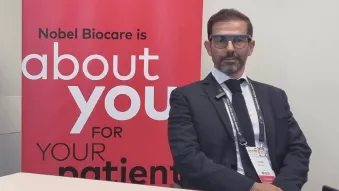
How do we test fatigue, screw loosening, primary stability and more?
Clinical studies are the ultimate proof of whether a dental implant system can truly deliver our goal of successful treatment outcomes. However, many aspects of the safety and efficacy of new products are simply impossible to measure outside the lab.
That’s why Nobel Biocare operates an engineering and biomechanics department at headquarters in Zürich, Switzerland, which has been especially important for the many mechanical developments in the new Nobel Biocare N1™ implant system.
See this video to see some of our lab activities, and read on for our interview with Molly Saade, biomechanics research manager, who we spoke with to find out more.
Let's delve more into the role of biomechanics in implant dentistry. How does biomechanics relate to dental implants, and what relevance does it have to daily practice?
Biomechanics is a branch of biophysics, it’s a fascinating field studying the structure, function and motion of biological systems, including the effects of external forces. Applying the laws of mechanics enables us to assess the safety and quality of implants and prosthetic components, and biomechanical testing has been instrumental in developing better and safer product designs.
Can you share some specific examples of how you test dental implant products?
One of the most important tests on all implants is of fatigue strength. We simulate the long-term chewing by continuously applying, removing and reapplying loads for two million cycles in air or saline solution. Before launching new implants at Nobel Biocare, we conduct extensive fatigue testing according to ISO 14801. This rigorous testing ensures the implant's fatigue strength and durability. Another critical test of the N1 Implant system is screw loosening behavior. The screw torque of N1 is 20 Ncm, where most other systems are tightened to 35 Ncm. Our published screw-loosening evaluation has shown stable behavior independently of applied load and number of cycles applied.1
The Nobel Biocare N1™ implant system is possibly the most important innovation in many years. How has biomechanics influenced this development?
Our team has played a crucial role. For example, we conducted fatigue strength testing for the worst-case combination of the system and evaluated screw loosening behavior. Our research showed that the N1 Implant maintained stable performance, regardless of the applied load or the number of cycles.2
We assessed primary stability during the N1 implant insertion and measured transversal forces as an indicator of circumferential stress, to ensure a low risk of bone ridge fracture. We found that the forces generated were lower than those during the insertion of an existing market-leading implant.
The N1 system is not just a new implant, but a new site preparation technique using the OsseoShaper™ instrument, which creates and osteotomy at low speed. What testing have you performed there?
Yes, we conducted specific tests on the OsseoShaper. Our evaluations included heat generation, noise reduction, and drill protocol testing. These tests were crucial to ensure that the OsseoShaper can work effectively at a low speed, as part of its design to reduce heat generation that causes cell death, alongside its design to minimize discomfort for the patient during site preparation. We presented the results in various research presentations, highlighting the reduction in noise generation and the effective heat generation of the OsseoShaper.
The drill protocol test was done to ensure that the implant can be seated without exceeding 70 Ncm limit as set in the IFU.
Impressive work! The N1 system also introduces the Trioval Conical Connection (TCC). What were your findings on this component?
The Trioval Conical Connection (TCC) underwent thorough leakage testing to evaluate its connection sealing properties. We compared it to traditional connections and found that the TCC performed better than the conical connection, with less dynamic gas leakage. This is a significant achievement in enhancing the reliability of the N1 system.
It's remarkable to see how your work is so crucial to successful implant dentistry. Are there any upcoming projects you're excited about?
Thank you, Chris. I'm continuously excited about the evolving field of biomechanics and its applications in healthcare. I believe there's always room for improvement and innovation. Currently, we're looking into further advancements in dental implant technology, exploring new materials, and pushing the boundaries of what's possible. It's an exciting time to be in this field.
References
1. Velikov, S., Fabech, J. and Heuberger, P. (2019), Mechanical properties of a novel conical connection. Clin Oral Impl Res, 30: 216-216. doi:10.1111/clr.174_13509
2. Yang B, Irastorza-Landa A, Heuberger P, Ploeg HL. Effect of insertion factors on dental implant insertion torque/energy-experimental results. Journal of the Mechanical Behavior of Biomedical Materials, vol. 112 (2020) Read here.
More biomechanical testing on Nobel Biocare N1™ system
IADR – Jérôme Zemp, Stefan Velikov, Sergej Weißbrot, Florian Fuchs. New low-speed site preparation protocol significantly reduces noise. 2020. https://iadr.abstractarchives.com/efs/20iags/3322476_Zemp.pdf
Agnieszka Meljon, Markus Geisendorf, Simon Kamber, Florian Fuchs, Ainara Irastorza-Landa. Evaluation of heat generated by a new site preparation using low-speed tools without irrigation. 2021. Read here
Velikov S, Susin C, Heuberger P, Irastorza-Landa A. A New Site Preparation Protocol That Supports Bone Quality Evaluation and Provides Predictable Implant Insertion Torque. J Clin Med. 2020;9(2).
Velikov S, Camenzind M, Fabech J, et al. Stability of a New Trioval Implant in Bone Surrogate Model. J Dent Res. 2020;99 (Spec Iss A):3052



